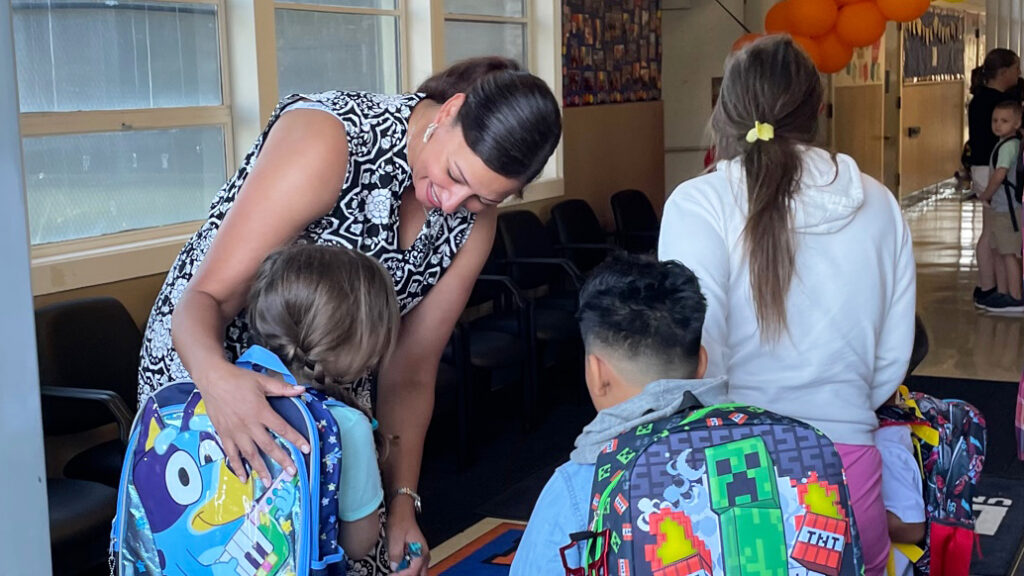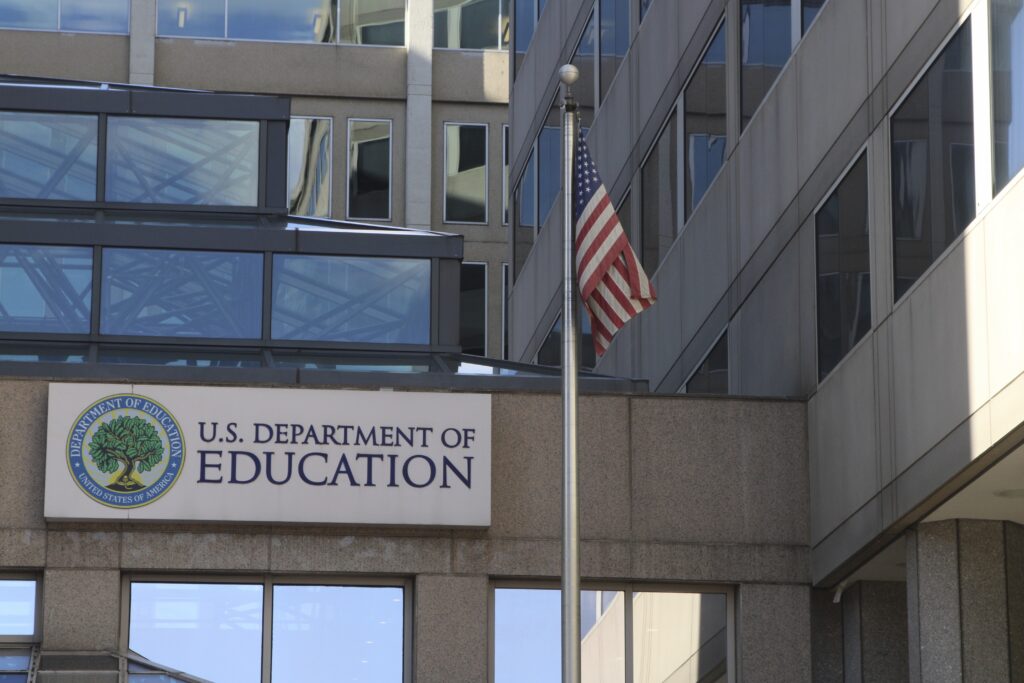
UC Berkeley students stroll around campus near the landmark Sather Gate on April 19, 2017.
Photos by Alison Yin for EdSource
Top Takeaways
- The law blocks graduate students from taking out new Grad PLUS loans and caps Parent PLUS loans starting in 2026.
- To maintain access to federal student loans, academic programs must soon show alumni earn more than peers without the same degree.
- The law expands Pell Grants to short-term workforce training and nixes an earlier proposal that likely would have reduced aid to many Pell recipients.
The domestic policy law signed by President Donald Trump will have major implications on how students in California and across the country pay for college, with analysts describing it as the most consequential federal higher education legislation in decades.
The most significant changes will impact access to federal loans and borrower repayment plans. The law also amends Pell Grant eligibility standards, expands qualified expenses for 529 college savings accounts, and is expected to raise the endowment tax on a few private universities, including Stanford.
Republican lawmakers say their suite of higher education policies aims to make college more affordable and reel in student debt while broadening access to career and technical education. Critics warn the package’s financial aid measures will do just the opposite, making higher education more expensive for low- and moderate-income students.
“This is the biggest set of changes to higher education policy in America since at least 1992,” said Robert Kelchen, a professor of higher education at the University of Tennessee, noting that the Higher Education Act hasn’t been reauthorized since 2008. “In this reconciliation bill, there are effectively pieces of legislation that congressional Republicans have been working on for years.”
The Grad PLUS program will stop accepting new borrowers
The federal Grad PLUS program, loans which make it possible for graduate students to borrow up to the cost of attendance minus other financial aid, will stop accepting borrowers this time next year. Current borrowers, however, will be grandfathered in and allowed to continue accessing those loans.
Graduate students will still have access to direct unsubsidized federal loans, but the bill caps those at $50,000 per year for students in professional programs, such as those studying to become lawyers or doctors, and most other graduate degrees at $20,500 per year.
The changes will reduce access to graduate school, particularly for low-income students who don’t have other funding options, said Melanie Storey, president and CEO of the National Association of Student Financial Aid Administrators, a nonprofit membership organization representing financial aid professionals at colleges across the country. “Very capable students who come from more modest backgrounds may be unwilling to pursue graduate or professional education.”
Some of those students may borrow from private lenders, but those loans “won’t come with the same kinds of terms and conditions and protections that a federal loan has,” she added.
The University of Southern California may be hit particularly hard by the loss of those PLUS loans. “They have so many graduate programs, and they have a lot of students who do not get financial aid,” Kelchen said.
The Grad PLUS program disbursed about $2 billion to students at California colleges and universities in the 2023-24 school year, federal data shows.
Lower caps on Parent PLUS loans will limit borrowing
Under the federal Parent PLUS loan program, parents used to have the ability to borrow up to the total cost of a student’s college education. A new cap starting July 2026 will limit borrowers to $20,000 per year and a lifetime maximum of $65,000 per student. Supporters argue that borrowing limits will slow rising tuition.
Parent PLUS loans have been “the loans of last resort” for students whose parents don’t qualify for private loans because of their credit, Kelchen said, so reducing the borrowing limit may hit students with substantial financial need the hardest. A brief by the Education Trust characterized them as “a double-edged sword for Black borrowers” in particular, who tend to have fewer resources to pay for college due to long-standing inequities in wealth and income.
Capping the Parent PLUS program will likely either “discourage students from attending college or limit their choices,” Storey said.
Institutions will need to get creative to ensure low-income and first-generation students can continue enrolling, said Emmanual Guillory, senior director of government relations at the American Council on Education.
“It’s hard to say that institutions will just find a way to make up the difference and will offer more institutional aid for low-income students to help them be able to cover the cost,” he said.
Former students’ earnings will determine loan access
The reconciliation bill puts postsecondary programs to a new test: In order to access federal student loans, alumni must earn more than peers who didn’t study for the same degree.
Congressional Republicans say the idea is to hold colleges and universities accountable for what alumni ultimately earn when they join the workforce. Loosely, for a given field of study, an undergraduate degree program can continue accessing federal loans if the median earnings of former students exceed the median earnings of high school graduates in the same state. Graduate programs maintain access to federal loans by comparing former students to similarly situated bachelor’s degree holders.
“It’s a really significant step towards the kind of focus on educational outcomes that we have seen both Republicans and Democrats talk about in recent years,” said Clare McCann, policy director at the Postsecondary Education & Economics Research Center. But McCann said it’s problematic that the measure doesn’t apply a similar standard to undergraduate certificate programs.
An analysis by Preston Cooper, a senior fellow at the right-leaning American Enterprise Institute, found that many associate degree programs could lose access to student loans, although associate degree students may be less likely to finance their educations in the first place.
“The promise of a lot of these programs is that you shouldn’t have to borrow,” Cooper said. “I kind of think that if these programs do have earnings outcomes that are so low, we probably shouldn’t be giving students loans for those programs, because it’s very unlikely that they’ll be able to repay their loans in full.”
SAVE, other repayment plans will close to new borrowers
The repayment terms will also change, reducing the number of plan choices to just two: a standard repayment plan and the Repayment Assistance Plan, which ties payment size to the borrower’s income. Supporters argue that doing so simplifies the options available to borrowers while putting them on a path to repay loan balances in full.
Most existing income-driven plans will later close to new borrowers, including the popular Saving on a Valuable Education (SAVE) plan, a Biden administration initiative aimed at lowering monthly payments. In California, about 600,000 borrowers are enrolled in the SAVE plan, according to the Student Borrower Protection Center.
“For most borrowers, their payments will be drastically more expensive on a monthly and annual basis,” said Aissa Canchola Bañez, policy director of the Student Borrower Protection Center.
Loan deferments for economic hardship will be eliminated, and new limits will be placed on forbearance.
Lawmakers nixed a Pell proposal that worried colleges
The version of the reconciliation bill passed by the U.S. House of Representatives would have increased academic credit requirements per semester to be considered a part-time or full-time student under the Pell Grant program. That proposal sparked concern among officials at California State University and the University of California that tens of thousands of their students would receive less money from Pell — or would lose eligibility altogether because they don’t take enough classes each term.
The universities may now breathe a sigh of relief: The final law makes more incremental adjustments to Pell, such as making students who receive full scholarships from other sources ineligible for Pell.
Students can use Pell for short-term workforce training
Starting in July 2026, Pell Grant recipients will be able to spend their awards on educational programs that last more than eight but less than 15 weeks at accredited institutions. Supporters of extending Pell to shorter programs say doing so will make educational programs more accessible to adult students who are already in the workforce.
Kelchen said workforce Pell Grants have gained traction among a broad spectrum of policymakers due to frustration regarding the value of a college degree. “The goal is, by trying to encourage short-term credentials, you get people in through [an educational program] fast and back out into the economy,” he said.
But some are skeptical about the return on investment of weeks-long credential programs. Wesley Whistle, a project director who monitors higher education policy at the left-leaning think tank New America, said student earnings after completing short-term certificate programs “aren’t good on average” and that even when they do boost earnings, the positive effect “tends to fade after a year or two.” Researchers with the Institute of Education Sciences reported similar findings.
Families with 529 plans will have more spending options
The law also makes several changes to 529 plans, investment accounts typically used to save money for college, in which earnings are tax-deferred and withdrawals for qualified educational expenses are tax-exempt. The new law, starting in 2026, adds items including tutoring, standardized testing fees and some educational therapies to the list of qualified expenses while students are in K-12. After high school, the law also allows funds to be used for some professional credentials, not just college.
Researchers at the Brookings Institution have found that 529 plans mainly benefit wealthy families while costing the federal government billions in tax revenue. “Low-income people don’t have enough money to be able to save in this way,” McCann said.
In California, the state’s 529 plan — ScholarShare 529 — managed more than $15.6 billion in more than 439,000 accounts as of June 2024.
A few selective universities will see an endowment tax hike
Critics, including the American Council on Education, have also warned that another provision of the law — increasing the endowment tax at a relatively small number of private universities from 1.4% to as much as 8% — could indirectly reduce the institutional financial aid available to their students. However, proponents argue that elite colleges hoard wealth while charging students exorbitant tuition. Based on their current endowment-to-student ratios, Stanford University and the California Institute of Technology would likely be among the universities to see a tax increase, while the University of Southern California, with its much larger student body, would probably be exempt.







